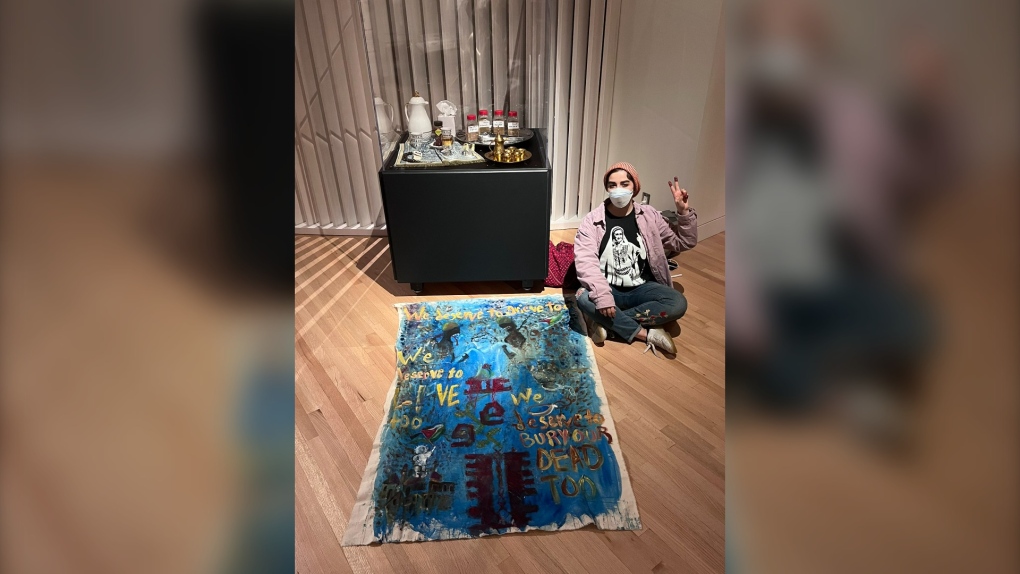‘Extremely hurtful’: Community organizer speaks out after ROM removes portion of exhibit that depicts Palestinian burial rituals
 An artist poses with the portion of their work initially removed by the ROM before being re-instated. Twitter
An artist poses with the portion of their work initially removed by the ROM before being re-instated. Twitter
The Royal Ontario Museum (ROM) has re-instated an exhibition after community advisors from the Chicago Field Museum staged an 18-hour sit-in to protest what they said amounted to censorship.
“Death: Life’s Greatest Mystery” opened at the ROM on Oct. 28. The exhibition claims to explore “how life and death are part of a universal, continuous and cyclical process.”
But in an Instagram post over the weekend, community advisors claimed the ROM had removed a panel depicting the word “Palestine” from the work without their permission, as well as “other texts and images relating to Palestine,” a move they collectively called “censorship.”
The artists staged a sit-in protest at the ROM that began late Saturday afternoon and continued into Sunday.
In their post, they said the ROM was “complicit in dehumanization of Palestinians in both life and death” by removing the hand-embroidered image of a poppy, which represents the Palestinian flag and the lives of those lost at the hands of occupation.
But in a statement to media on Sunday, representatives for the ROM said the museum had merely “proposed modifications to some content in an effort to keep the focus of the exhibition on the cultural practices, rituals, and science surrounding life and death, rather than current events.
“Making adjustments to touring exhibitions and adapting content for the local audience is standard museum practice, and is done in consultation with the originating institution,” the statement noted.
The ROM has said that the exhibition will be temporarily closed while they reinstate the materials related to Palestinian Muslim burial practices and Jewish cultural content, as originally displayed at the Field Museum in Chicago.
“The proposed changes to materials related to Palestinian cultural traditions were brought to the Field Museum's community advisory members, starting a dialogue which has now come to a resolution. As a result of these conversations, ROM will present the panels and labels related to Palestinian Muslim burial practices and Jewish cultural content as originally displayed,” the statement notes. In a follow-up statement, representatives for the ROM said proposed adjustments were brought to the Field Museum and their community advisors for discussion "with the understanding that the labels and panels would not be installed until an agreement was reached."
But the artists say they are still upset with their treatment.
In an interview with CP24 on Wednesday Jenin Yaseen, one of the affected artists, said the ROM has proposed adding a disclaimer on the exhibit saying that the views expressed in the artwork do not reflect those of the museum.
She said that doing so “invalidates” her experience and voice.
“I feel like the museum…is completely dehumanizing me, invalidating my experiences and realities. A disclaimer isn’t necessary. I don’t see any other art pieces that have that,” she said.
Yaseen says she hopes ROM visitors who see the artwork are able to take away that the Palestinians depicted in the canvas are “not just numbers.”
“They’re human beings with dreams and hopes, and they’re being completely eradicated,” she said.
“We are all grieving.”
CTVNews.ca Top Stories

BREAKING Prime Minister Justin Trudeau's plane lands near Donald Trump's Mar-a-Lago estate
Prime Minister Justin Trudeau's plane landed in West Palm Beach, Fla., this evening, not far from where incoming U.S. president Donald Trump's transition team is based at his Mar-a-Lago estate. The Prime Minister's Office is refusing to comment on whether the two are meeting.
'Mayday! Mayday! Mayday!': Details emerge in Boeing 737 incident at Montreal airport
New details suggest that there were communication issues between the pilots of a charter flight and the control tower at Montreal's Mirabel airport when a Boeing 737 made an emergency landing on Wednesday.
Hit man offered $100,000 to kill Montreal crime reporter covering his trial
Political leaders and press freedom groups on Friday were left shell-shocked after Montreal news outlet La Presse revealed that a hit man had offered $100,000 to have one of its crime reporters assassinated.
Cucumbers sold in Ontario, other provinces recalled over possible salmonella contamination
A U.S. company is recalling cucumbers sold in Ontario and other Canadian provinces due to possible salmonella contamination.
John Herdman resigns as head coach of Toronto FC
John Herdman, embroiled in the drone-spying scandal that has dogged Canada Soccer, has resigned as coach of Toronto FC.
Musk joins Trump and family for Thanksgiving at Mar-a-Lago
Elon Musk had a seat at the family table for Thanksgiving dinner at Mar-a-Lago, joining President-elect Donald Trump, Melania Trump and their 18-year-old son.
Billboard apologizes to Taylor Swift for video snafu
Billboard put together a video of some of Swift’s achievements and used a clip from Kanye West’s music video for the song “Famous.”
Trudeau says no question Trump is serious on tariff threat
Prime Minister Justin Trudeau says incoming U.S. president Donald Trump's threats on tariffs should be taken seriously.
In a shock offensive, insurgents breach Syria's largest city for the first time since 2016
Insurgents breached Syria's largest city Friday and clashed with government forces for the first time since 2016, according to a war monitor and fighters, in a surprise attack that sent residents fleeing and added fresh uncertainty to a region reeling from multiple wars.


































